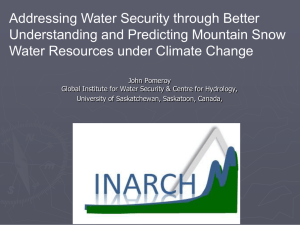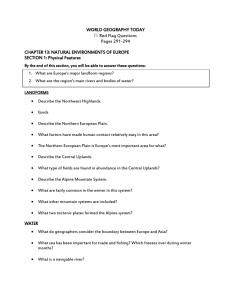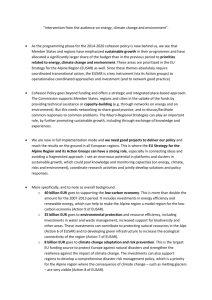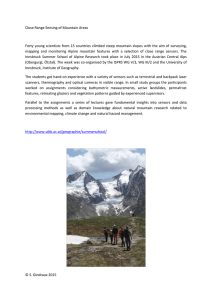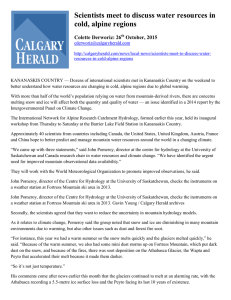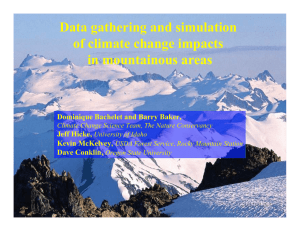INARCH: International Network for Alpine Research Catchment Hydrology Cross-cut Project
advertisement
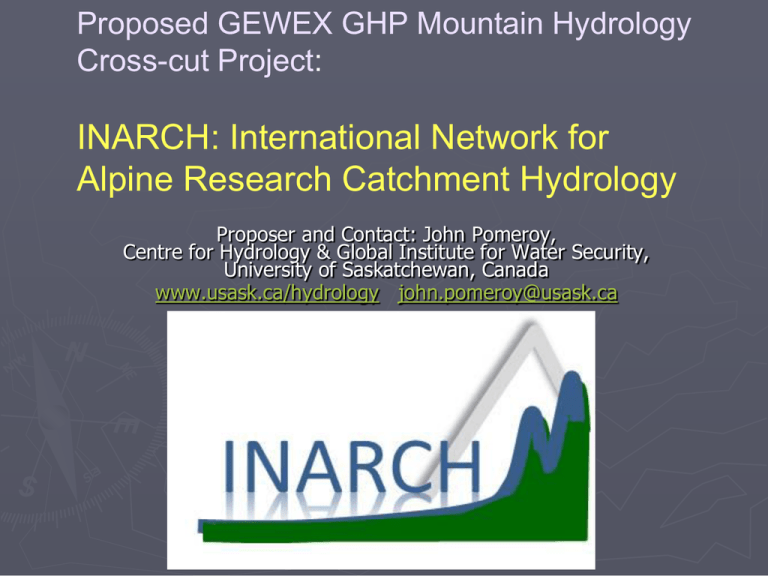
Proposed GEWEX GHP Mountain Hydrology Cross-cut Project: INARCH: International Network for Alpine Research Catchment Hydrology Proposer and Contact: John Pomeroy, Centre for Hydrology & Global Institute for Water Security, University of Saskatchewan, Canada www.usask.ca/hydrology john.pomeroy@usask.ca Co-Proposers ► ► ► ► ► ► ► ► ► ► ► ► Lugwig Braun, Bavarian Academy of Sciences & Humanities, Germany Karsten Schulz, BOKU, Vienna, Austria Matthias Bernhardt, BOKU, Vienna, Austria Xin Li, CAREERI, Chinese Academy of Sciences, Lanzhou, China Richard Harding, Centre for Ecology & Hydrology, Wallingford, England James McPhee, Dept. of Civil Engineering, University of Chile, Santiago, Chile Nick Rutter, Dept. of Geography, University of Northumbria, Newcastle, England Peter Jansson, Dept. of Physical Geography, Stockholm University, Sweden Joseph Shea, ICIMOD, Nepal Ignacio Lopez Moreno – CSIC, Institute for Pyrenean Ecology, Zaragoza, Spain Yaoming Ma, Institute for Tibetan Plateau, Chinese Academy of Sciences, Beijing, China Vincenzo Levizzani, Institute of Atmospheric Sciences & Climate, Bologna, Italy ► ► ► ► ► ► ► ► ► ► ► ► ► Ulrich Strasser, Institute of Geography, University of Innsbruck, Austria Georg Kaser, Institute of Meteorology & Geophysics, University of Innsbruck, Austria Anil Mishra, International Hydrological Programme, UNESCO, Paris, France Isabella Zin, LTHE, Grenoble, France Vincent Vionnet, Meteo France, Grenoble, France Martyn Clark, NCAR, Boulder, USA Roy Rasmussen, NCAR, Boulder, USA Richard Essery, School of Geosciences, University of Edinburgh, Scotland Tobias Jonas, SLF, Davos, Switzerland Walter Immerzeel, Universiteit Utrecht, Netherlands Danny Marks, USDA ARS, Boise, USA Alain Pietroniro, Water Survey of Canada, Environment Canada Rick Janowicz, Yukon Environment, Canada Urgency ► to IPCC (2014) WG II report – “In many regions, changing precipitation or melting snow and ice are altering hydrological systems, affecting water resources in terms of quantity and quality” Alpine catchments receive and produce a disproportionately large fraction of global precipitation and runoff including contributions to floods and water supply for vast downstream areas. ► Snowfall does not equal accumulation on the ground! ► Snow, ice, and phase change domination of alpine hydrology means that it is especially sensitive to temperature change. ► Significance Understanding the sensitivity of alpine hydrological processes to changing high elevation climate is of disproportionate importance to global water and energy exchange and downstream water resources. ► Ongoing change in climate has already resulted in shorter seasonal snowcover duration, earlier spring hydrographs, greater rainfall fraction of total precipitation, glacier volume decline, ground thaw and woody vegetation increase in many alpine catchments. ► Some alpine catchments are contributing to higher frequency of floods and/or droughts. ► Alpine Regions are Data Scarce Left Side: Altitudinal distribution of global runoff stations represented in the GRDC archive and global precipitation station network represented in the GPCC archive compared to global hypsography of the land surface area (without Greenland and Antarctica). The inset shows a magnification for altitudes above 1500ma.s.l. (Viviroli et al. 2011). Right Side: Hypsometric curve of cumulative frequency (or percentage above this elevation) for terrain area, volume of precipitation, number of weather stations and number of hydrometric stations as a function of elevation in the Canadian Rocky Mountain National Parks (UNESCO World Heritage Site) and a 50 km buffer zone around them (Pomeroy, Sinclair – in preparation). Research Need A concerted global effort is needed to address how changing high mountain hydrological processes will mediate the influence of atmospheric change in alpine catchments. Objectives Overall: to better understand alpine cold regions hydrological processes, improve their prediction and find consistent measurement strategies. To achieve this objective it is necessary to develop transferable and validated model schemes of different complexity that can support research in data sparse mountain areas dominated by elements of snow, permafrost and glacier cover. Sub-Objectives 1. How different are the measurement standards and the standards for field sampling and do we expect distinctive differences in model results and hydrological predictability because of the sampling schemes, data quality and data quantity? 2. How do the predictability, uncertainty and sensitivity of catchment energy and water exchange vary with changing atmospheric dynamics in various high mountain regions of the Earth? 3. What improvements to high mountain energy and water exchange predictability are possible through improved physics in land surface hydrological models, improved downscaling of atmospheric models in complex terrain, and improved approaches to data collection and assimilation of both in-situ and remotely sensed data? 4. Do the existent model routines have a global validity, are they transferable and are they meaningful in different mountain environments? 5. How do transient changes in perennial snowpacks, glaciers, ground frost, soil stability, and vegetation impact models of water and energy cycling in high mountain catchments? Data Requirements Surface based data requirements for this project will primarily be met by openly-available detailed meteorological and hydrological observational archives from long-term research catchments at high temporal resolution in selected heavily instrumented alpine regions, atmospheric model reanalyses, downscaled climate model as well as regional climate model outputs. Data Standards At least 5 years of continuous data with hourly sampling intervals for meteorological data, daily precipitation and streamflow, and regular snow and/or glacier mass balance surveys ► The ideal sites will be Integrated Alpine Observing and Predicting Systems (IAOPS). IAOPS are classified for assessment as: ► CLASS A: sites receiving technology transfer and developing towards CLASS B to E. CLASS B: Single measurement points with highly accurate driving data and snow or glacier data, CLASS C: gauged catchments that contain Class B sites and detailed vegetation coverage, soils, topography, snowcovered area, glacier mass balance or permafrost information, CLASS D: domains for which high resolution gridded meteorological data is available that includes CLASS C sites, CLASS E: the same as CLASS D but gridded meteorological data is also available as climate change scenarios. Activities 1. Facilitate exchange and collaboration by 2. Improve algorithm development by 3. 5. 6. 7. 8. conducting process algorithm intercomparisons, defining optimal characteristic parameterisations conducting uncertainty analyses to quantify algorithm reliability. Examine hydrological model sensitivity to atmospheric change in global alpine environments focussing on 4. comparing instrumentation best practices, suggesting improvements in instrumentation, developing reliable alpine datasets for model testing and numerical experiments snowpack, permafrost, glacier mass balance, groundwater and vegetation changes. Demonstrate improvements to model predictability that can be realised from data assimilation, downscaling and model structural improvements. Exploration of the ability of different regional scale meteorological model setups and parameterisations to reproduce mountain forcing fields. Evaluation of different downscaling schemes from meteorological to hydrological models in mountains. Foster research and development activities and coherent planning for future observing schemes and international network optimization. Facilitate education and training programmes to build and enhance capacities at various levels and popularize science results with the public. Alpine Hydrological Model Toolbox derived from Cold Regions Hydrological Model ► Model components ► Blowing snow redistribution, sublimation and melt Forest and shrub canopy effects Actual evapotranspiration, frozen & unfrozen soil infiltration, soil moisture and groundwater balance, routing Ability to perturb the model via temperature and preciptiation changes Affects precipitation phase Affects hydrological processes Reynolds Creek, Idaho, USA Impact of Sheltering 1C 1C Rasouli et al. in review Effect of Aspect on Peak SWE and Snow Duration – Izas, Pyrenees 40 Izas Aspect vs IzasP1 Aspect vs 20 Difference in DSP compared to flat area (days) Difference in MSWE compared to flat area (%) 40 IzasP1 0 -20 -40 E SE S SW W NW N NE Izas 20 0 -20 -40 E SE S SW W Long-term average difference (%) in the annual maximum snow accumulation (MSWE) and snow duration of the snow pack (DSP) for each slope aspect compared with flat conditions. NW N NE LopezMoreno et al 2014 Zugspitze, Germany – Altitude Effects 1C 1.5 C 3C 2C Weber et al. 2015 Wolf Creek, Yukon, Canada Ecozone Effects 3C Alpine 3C ShrubTundra 3C Forest Rasouli et al., 2014 16 Wolf Creek, Yukon, Canada Streamflow Impact Alpine ShrubTundra Forest Rasouli et al., 2014 17 Integrated Alpine Observing & Predicting Systems - IAOPS Instrumented alpine catchments with, remote sensing, atmospheric modelling, downscaling, data assimilation in order to better evaluate mountain water and energy exchange. Improved Snow Measurements International Collaboration through Field & Model Experiments Upper Heihe River Basin, 4150 m China Schneefernerhaus, Zugspitze, 2650 m Germany INARCH: International Network for Alpine Research Catchment Hydrology Canada – Canadian Rockies & Yukon; USA – Reynolds Creek, Idaho. Chile - Upper Maipo & Upper Diguillín River Basins, Andes, Germany – Schneefernerhaus & Zugspitze; France – Arve Catchement, Col de Porte & Col du Lac Blanc; Switzerland – Dischma & Weissfluhjoch; Austria - OpAL Open Air Laboratory, Rofental Spain – Izas, Pyrenees; China – Upper Heihe River, Tibetan Plateau, Nepal – Langtang Catchment, Himalayas Integrated Alpine Observing and Predicting Systems (IAOPS), initial sites to be considered Linkages ► UNESCO-International Hydrological Programme efforts on climate change impacts on snow, glacier and water resources within the framework of IHP-VIII (2014-2021) ‘Water Security: Responses to Local Regional and Global Challenges’. ► International Commission for Snow and Ice Hydrology (IAHS-IUGG-ICSU) ► GHP Proposed Crosscut Projects Precipitation phase Mountain precipitation Next Steps ► AGU Dec 2014 Sessions on snow hydrology and glacio-hydrology. ► ► Initialisation of workshops to promote scientific integration Joint field and modelling experiments through scientific exchanges, resulting in multi-authored papers Joint development of an open-access Alpine Hydrological Modelling Toolbox. Joint development of an open-access Alpine Downscaling Toolbox. Promote the development of other catchments so that they can match the data availability requirements into the INACH initiative through scientific exchanges. Snow hydrology model climate change sensitivity experiments with the Toolbox: Spain, USA, Germany, Canada (so far) Model snow process evaluation and algorithm intercomparison exercises using archived datasets to evaluate the prevalence and operation of various snow accumulation, redistribution and ablation processes in differing global alpine environments. ► ► ► ► ► Funding Needs Collaborators in INARCH are expected to have their primary scientific research funded to contribute to this project and operate Integrated Alpine Observing and Predicting Systems (where applicable). Core funding to the project is needed to facilitate collaboration and central project operation through: ► Travel funding support for workshops, scientific exchanges, joint field and modelling experiments, ► User support for and central modelling development of Modelling and Downscaling Toolboxes ► Data management of the data repository and model outputs for intercomparison experiments ► Outreach and training activities.
